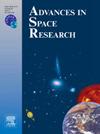Capabilities of the GAMMA-400 gamma-ray telescope to study the relationship between high-energy particle precipitation from the Earth’s inner radiation belt and electromagnetic radiation of gamma-ray bursts
IF 2.8
3区 地球科学
Q2 ASTRONOMY & ASTROPHYSICS
引用次数: 0
Abstract
Capabilities of the GAMMA-400 gamma-ray telescope for measurements of gamma-ray bursts (GRB) spectra under 100 MeV turns out to be very useful in the view of relationship between high-energy particle precipitation from the Earth’s inner radiation belt and the electromagnetic radiation from the GRB’s. The search of possible correlation between these phenomena is motivated by the results from the PAMELA spectrometer where we found and analyzed several such events corresponding to precipitating particles of energies more than 50 MeV. To date, no studies have been found that paid attention to the influence of sources of electromagnetic radiation of GRB on precipitation of geomagnetically trapped particles. In this view, detailed measurements of GRB spectrum especially in the energy range up to 100 MeV, is quite important for establishing a theoretical framework to explain a possible mechanism of particles’ precipitation due to GRB or to discard the hypothesis of their interconnection.
伽玛-400伽玛射线望远镜研究地球内辐射带高能粒子沉淀与伽玛射线暴电磁辐射之间关系的能力
伽玛-400伽玛射线望远镜测量100 MeV以下伽玛射线暴(GRB)光谱的能力在研究地球内辐射带高能粒子沉降与GRB电磁辐射之间的关系方面是非常有用的。PAMELA光谱仪的结果激发了对这些现象之间可能的相关性的研究,我们发现并分析了几个与能量超过50兆电子伏特的沉淀粒子相对应的事件。迄今为止,尚未发现有研究关注GRB电磁辐射源对地磁捕获粒子沉降的影响。在这种观点中,GRB光谱的详细测量,特别是在高达100 MeV的能量范围内,对于建立理论框架来解释GRB导致粒子沉淀的可能机制或放弃它们相互联系的假设是非常重要的。
本文章由计算机程序翻译,如有差异,请以英文原文为准。
求助全文
约1分钟内获得全文
求助全文
来源期刊

Advances in Space Research
地学天文-地球科学综合
CiteScore
5.20
自引率
11.50%
发文量
800
审稿时长
5.8 months
期刊介绍:
The COSPAR publication Advances in Space Research (ASR) is an open journal covering all areas of space research including: space studies of the Earth''s surface, meteorology, climate, the Earth-Moon system, planets and small bodies of the solar system, upper atmospheres, ionospheres and magnetospheres of the Earth and planets including reference atmospheres, space plasmas in the solar system, astrophysics from space, materials sciences in space, fundamental physics in space, space debris, space weather, Earth observations of space phenomena, etc.
NB: Please note that manuscripts related to life sciences as related to space are no more accepted for submission to Advances in Space Research. Such manuscripts should now be submitted to the new COSPAR Journal Life Sciences in Space Research (LSSR).
All submissions are reviewed by two scientists in the field. COSPAR is an interdisciplinary scientific organization concerned with the progress of space research on an international scale. Operating under the rules of ICSU, COSPAR ignores political considerations and considers all questions solely from the scientific viewpoint.
 求助内容:
求助内容: 应助结果提醒方式:
应助结果提醒方式:


